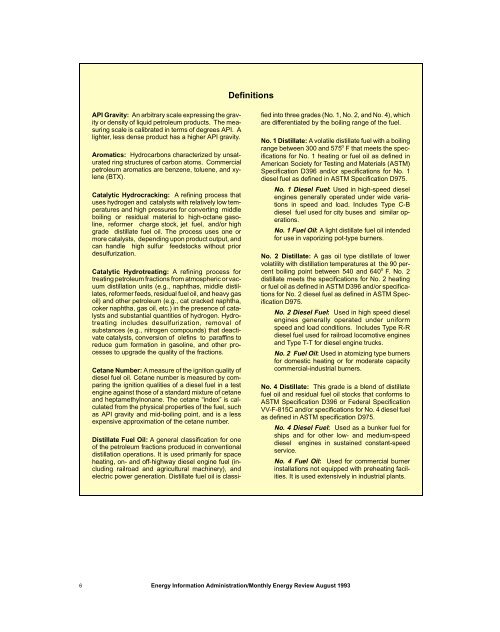Demand, Supply, and Price Outlook for Low-Sulfur Diesel Fuel - EIA
Demand, Supply, and Price Outlook for Low-Sulfur Diesel Fuel - EIA
Demand, Supply, and Price Outlook for Low-Sulfur Diesel Fuel - EIA
Create successful ePaper yourself
Turn your PDF publications into a flip-book with our unique Google optimized e-Paper software.
6<br />
API Gravity: An arbitrary scale expressing the gravity<br />
or density of liquid petroleum products. The measuring<br />
scale is calibrated in terms of degrees API. A<br />
lighter, less dense product has a higher API gravity.<br />
Aromatics: Hydrocarbons characterized by unsaturated<br />
ring structures of carbon atoms. Commercial<br />
petroleum aromatics are benzene, toluene, <strong>and</strong> xylene<br />
(BTX).<br />
Catalytic Hydrocracking: A refining process that<br />
uses hydrogen <strong>and</strong> catalysts with relatively low temperatures<br />
<strong>and</strong> high pressures <strong>for</strong> converting middle<br />
boiling or residual material to high-octane gasoline,<br />
re<strong>for</strong>mer charge stock, jet fuel, <strong>and</strong>/or high<br />
grade distillate fuel oil. The process uses one or<br />
more catalysts, depending upon product output, <strong>and</strong><br />
can h<strong>and</strong>le high sulfur feedstocks without prior<br />
desulfurization.<br />
Catalytic Hydrotreating: A refining process <strong>for</strong><br />
treating petroleum fractions from atmospheric or vacuum<br />
distillation units (e.g., naphthas, middle distillates,<br />
re<strong>for</strong>mer feeds, residual fuel oil, <strong>and</strong> heavy gas<br />
oil) <strong>and</strong> other petroleum (e.g., cat cracked naphtha,<br />
coker naphtha, gas oil, etc.) in the presence of catalysts<br />
<strong>and</strong> substantial quantities of hydrogen. Hydrotreating<br />
includes desulfurization, removal of<br />
substances (e.g., nitrogen compounds) that deactivate<br />
catalysts, conversion of olefins to paraffins to<br />
reduce gum <strong>for</strong>mation in gasoline, <strong>and</strong> other processes<br />
to upgrade the quality of the fractions.<br />
Cetane Number: A measure of the ignition quality of<br />
diesel fuel oil. Cetane number is measured by comparing<br />
the ignition qualities of a diesel fuel in a test<br />
engine against those of a st<strong>and</strong>ard mixture of cetane<br />
<strong>and</strong> heptamethylnonane. The cetane “index” is calculated<br />
from the physical properties of the fuel, such<br />
as API gravity <strong>and</strong> mid-boiling point, <strong>and</strong> is a less<br />
expensive approximation of the cetane number.<br />
Distillate <strong>Fuel</strong> Oil: A general classification <strong>for</strong> one<br />
of the petroleum fractions produced in conventional<br />
distillation operations. It is used primarily <strong>for</strong> space<br />
heating, on- <strong>and</strong> off-highway diesel engine fuel (including<br />
railroad <strong>and</strong> agricultural machinery), <strong>and</strong><br />
electric power generation. Distillate fuel oil is classi-<br />
Definitions<br />
fied into three grades (No. 1, No. 2, <strong>and</strong> No. 4), which<br />
are differentiated by the boiling range of the fuel.<br />
No. 1 Distillate: A volatile distillate fuel with a boiling<br />
range between 300 <strong>and</strong> 575 o F that meets the specifications<br />
<strong>for</strong> No. 1 heating or fuel oil as defined in<br />
American Society <strong>for</strong> Testing <strong>and</strong> Materials (ASTM)<br />
Specification D396 <strong>and</strong>/or specifications <strong>for</strong> No. 1<br />
diesel fuel as defined in ASTM Specification D975.<br />
No. 1 <strong>Diesel</strong> <strong>Fuel</strong>: Used in high-speed diesel<br />
engines generally operated under wide variations<br />
in speed <strong>and</strong> load. Includes Type C-B<br />
diesel fuel used <strong>for</strong> city buses <strong>and</strong> similar operations.<br />
No. 1 <strong>Fuel</strong> Oil: A light distillate fuel oil intended<br />
<strong>for</strong> use in vaporizing pot-type burners.<br />
No. 2 Distillate: A gas oil type distillate of lower<br />
volatility with distillation temperatures at the 90 percent<br />
boiling point between 540 <strong>and</strong> 640 o F. No. 2<br />
distillate meets the specifications <strong>for</strong> No. 2 heating<br />
or fuel oil as defined in ASTM D396 <strong>and</strong>/or specifications<br />
<strong>for</strong> No. 2 diesel fuel as defined in ASTM Specification<br />
D975.<br />
No. 2 <strong>Diesel</strong> <strong>Fuel</strong>: Used in high speed diesel<br />
engines generally operated under uni<strong>for</strong>m<br />
speed <strong>and</strong> load conditions. Includes Type R-R<br />
diesel fuel used <strong>for</strong> railroad locomotive engines<br />
<strong>and</strong> Type T-T <strong>for</strong> diesel engine trucks.<br />
No. 2 <strong>Fuel</strong> Oil: Used in atomizing type burners<br />
<strong>for</strong> domestic heating or <strong>for</strong> moderate capacity<br />
commercial-industrial burners.<br />
No. 4 Distillate: This grade is a blend of distillate<br />
fuel oil <strong>and</strong> residual fuel oil stocks that con<strong>for</strong>ms to<br />
ASTM Specification D396 or Federal Specification<br />
VV-F-815C <strong>and</strong>/or specifications <strong>for</strong> No. 4 diesel fuel<br />
as defined in ASTM specification D975.<br />
No. 4 <strong>Diesel</strong> <strong>Fuel</strong>: Used as a bunker fuel <strong>for</strong><br />
ships <strong>and</strong> <strong>for</strong> other low- <strong>and</strong> medium-speed<br />
diesel engines in sustained constant-speed<br />
service.<br />
No. 4 <strong>Fuel</strong> Oil: Used <strong>for</strong> commercial burner<br />
installations not equipped with preheating facilities.<br />
It is used extensively in industrial plants.<br />
Energy In<strong>for</strong>mation Administration/Monthly Energy Review August 1993

















